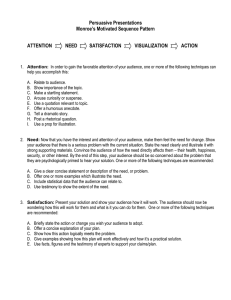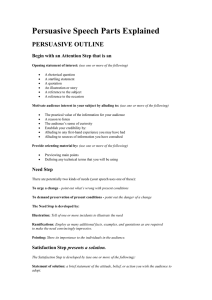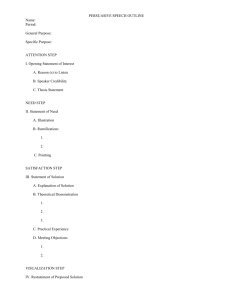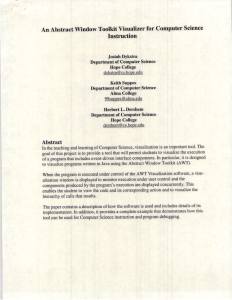Outline
advertisement
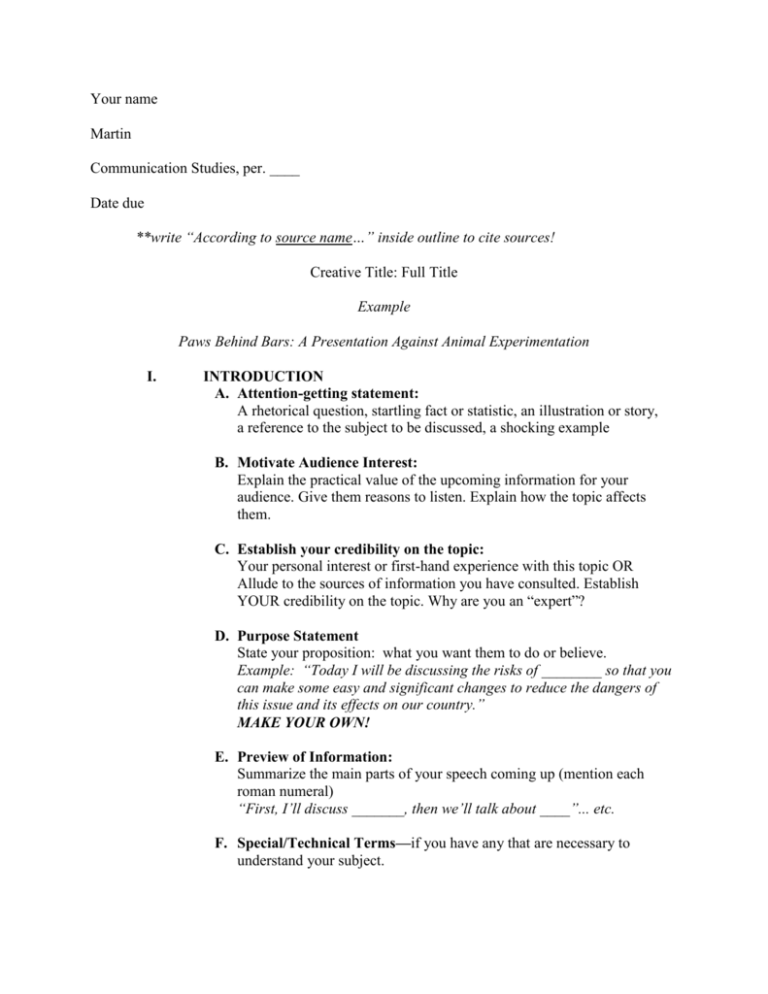
Your name Martin Communication Studies, per. ____ Date due **write “According to source name…” inside outline to cite sources! Creative Title: Full Title Example Paws Behind Bars: A Presentation Against Animal Experimentation I. INTRODUCTION A. Attention-getting statement: A rhetorical question, startling fact or statistic, an illustration or story, a reference to the subject to be discussed, a shocking example B. Motivate Audience Interest: Explain the practical value of the upcoming information for your audience. Give them reasons to listen. Explain how the topic affects them. C. Establish your credibility on the topic: Your personal interest or first-hand experience with this topic OR Allude to the sources of information you have consulted. Establish YOUR credibility on the topic. Why are you an “expert”? D. Purpose Statement State your proposition: what you want them to do or believe. Example: “Today I will be discussing the risks of ________ so that you can make some easy and significant changes to reduce the dangers of this issue and its effects on our country.” MAKE YOUR OWN! E. Preview of Information: Summarize the main parts of your speech coming up (mention each roman numeral) “First, I’ll discuss _______, then we’ll talk about ____”... etc. F. Special/Technical Terms—if you have any that are necessary to understand your subject. II. BODY-- NEED STEP (This is where you establish that a need for a change. SHOW US THAT A PROBLEM EXISTS and that we NEED A SOLUTION. A. Your proposition: You choose—you must either URGE A CHANGE- point out what’s wrong with the current practice Or DEMAND PRESERVATION OF CURRENT CONDITIONS- point out the danger of a change, show why we need to keep practice the same B. Illustration Tell of MULTIPLE, CITED EXAMPLES AND INCIDENTS that illustrate the need for change. You need a MINIMUM OF SIX. Establish a thorough fact base. Use multiple sources. Remember “according to….” 1. 2. 3. 4.This is where you will put the most FACTS from your sources 5. 6. Etc. C. Ramifications Use as many additional facts, examples, and quotations as are required to make the need convincing to your audience. These are different than “illustration” because they show the repercussions of the issue (ex. Because we have not lowered the BAC limit from .08 for drunk driving, according to Jones, drunk driving accidents increased 5% in 2010.) D. Pointing Show the importance of the issue to the audience. Make it matter to us. Explain how this issue impacts your audience or how it could impact them in the future. III. BODY- SATISFACTION STEP (this is where you present a solution) A. Statement of solution A statement of the attitude, belief, or action you wish the audience to adopt. YOU CAN CREATE YOUR OWN SOLUTION TO THE PROBLEM IF YOU WISH, OR ADOPT ONE FROM YOUR SOURCES. B. Explanation Explain the details of your proposal to the audience. Make sure it is clear. C. Theoretical Demonstration Give evidence of how your solution would theoretically prevent the problem. Use logic and explain. Or Practical Experience Cite an actual example from your source showing where this proposal has already worked effectively. IV. BODY- VISUALIZATION STEP The visualization shows how your solution would play out. It must stand the test of reality. The conditions you describe here must be at least realistic. The more vividly you describe the situation (PATHOS, word choice), the stronger your audience reaction will be. You should do A and B. A. Positive Visualization: Describe the conditions in your solution is actually carried out. Explain the safety, pleasure, or peace that your solution will produce. Describe this to your audience. Be practical and descriptive. B. Negative Visualization: Describe the conditions that will occur if your solution is not carried out or if your issue continues to be ignored. Picture the audience feeling the bad effects that the failure to solve this problem will produce. Explain this to them. V. CONCLUSION- ACTION STEP A. Restatement of purpose Repeat your proposal. B. Summarize your main points Example: “We went over the issue of _____, I showed you why it is a problem, what we can do to solve it, and how my solution meets objections.” C. Call to Action - - REALLY IMPORTANT! Statement of specific action you want from the audience. WHAT DO YOU WANT THEM TO DO ABOUT THIS SPECIFICALLY? Example: You can write your local congressmen and congresswomen…. You can join _____ Society at www…… You can tell your friends and neighbors… You can support ___ cause with money, time, etc. You can avoid _____ and instead _______.... D. State your personal intent to take the course of action or attitude “Personally, I plan to…” or “I already have ….” E. Clincher Recapture interest, tie your speech into a full circle, and give them a powerful reason to remember your message.



